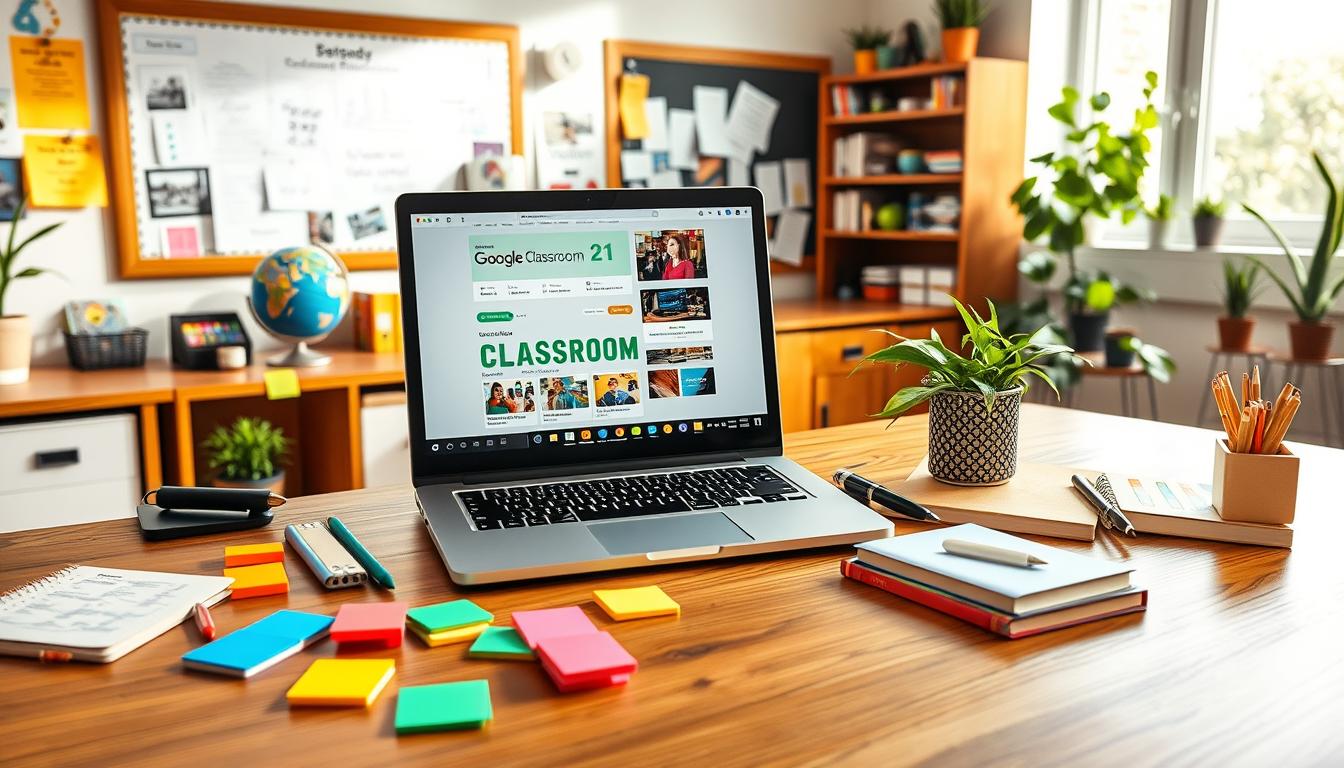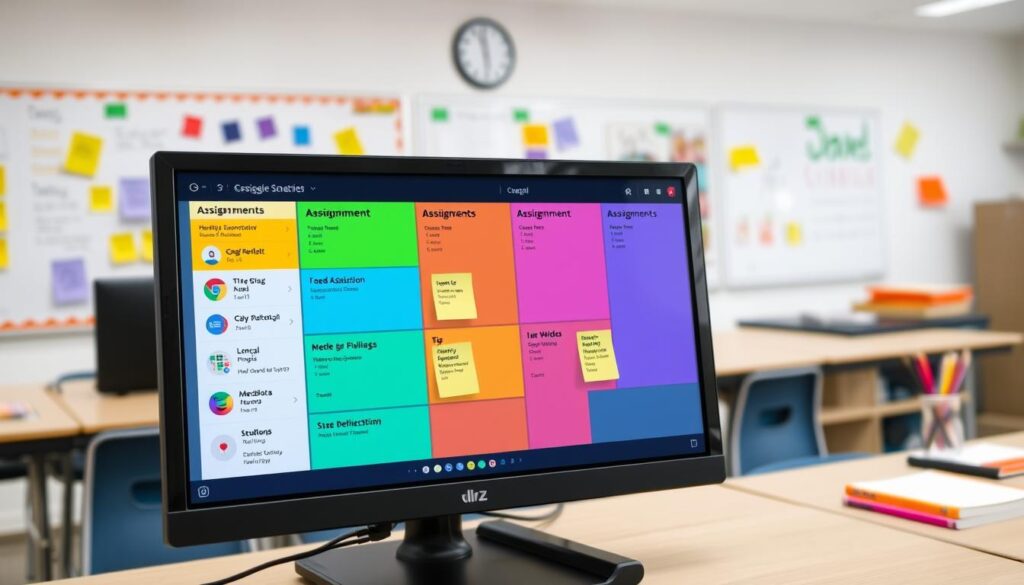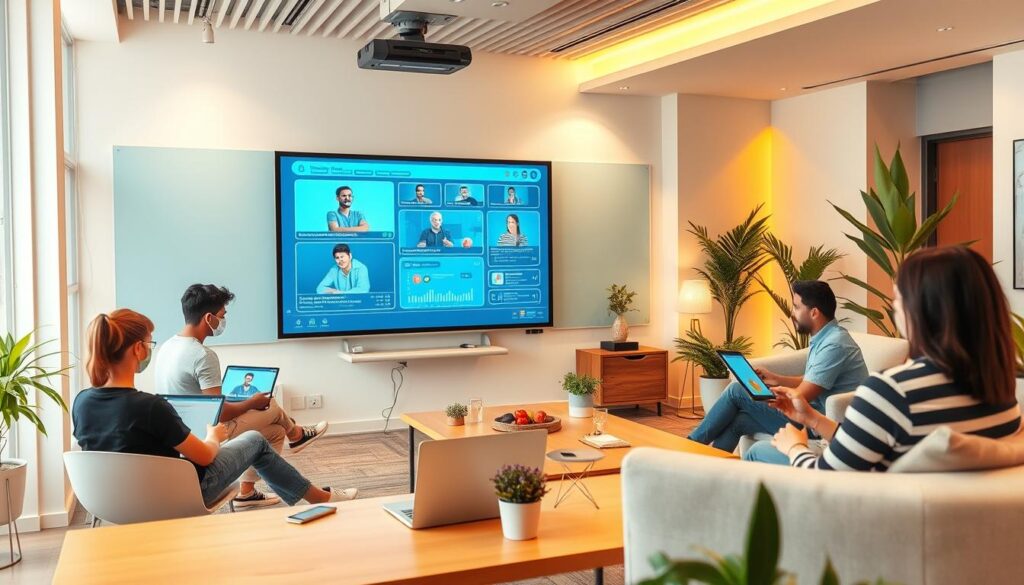
In today’s rapidly evolving digital landscape, the demand for effective online learning solutions has never been more critical. As educators and students navigate the new frontier of remote and hybrid education, a platform that seamlessly bridges the gap between the physical and virtual realms is essential. Enter Google Classroom 6x – the next-generation learning management system that is poised to transform the way we approach education.
But what sets Google Classroom 6x apart from its predecessors, and how can it truly be considered the ultimate learning platform? The answer lies in its unparalleled suite of features, designed to empower educators, engage students, and foster a dynamic, collaborative learning environment.
What unique capabilities does Google Classroom 6x offer that make it a game-changer in the world of online education?
Key Takeaways
- Google Classroom 6x is a next-generation learning management system that bridges the gap between physical and virtual education
- It offers a robust set of features designed to empower educators, engage students, and foster a dynamic, collaborative learning environment
- The platform’s advanced capabilities set it apart as a game-changer in the world of online education
- Discover how Google Classroom 6x can revolutionize your teaching and learning experiences
- Explore the platform’s key features and uncover the hidden gems that make it the ultimate learning solution
Introduction to Google Classroom
Google Classroom is a powerful e-learning tool that has revolutionized the way educators and students collaborate in the digital education landscape. As a free web-based platform developed by Google, it serves as a central hub for classroom activities, fostering seamless collaborative learning and improving communication between teachers and students.
What is Google Classroom?
Google Classroom is a comprehensive digital education platform that simplifies the process of creating, distributing, and grading assignments. It allows teachers to easily manage their classrooms, share resources, and provide feedback to students, all within a single, user-friendly interface.
Key Features of Google Classroom
- Streamlined assignment creation and distribution
- Seamless integration with Google’s suite of productivity tools, including Google Drive, Google Docs, and Google Slides
- Efficient grading and feedback mechanisms
- Effective communication channels, including announcements and private messaging
- Collaborative features that enable students to work together on projects
- Mobile accessibility, allowing students to access classroom content on the go
By leveraging the power of Google Classroom, educators can create a dynamic and engaging learning environment that caters to the needs of modern students. This e-learning tool empowers teachers to streamline their workflow, foster collaborative learning, and ultimately, enhance the overall digital education experience for both themselves and their students.
Setting Up Your Google Classroom
Crafting an engaging, cloud-based application for the modern classroom can be a transformative experience for educators and students alike. Google Classroom, a free and intuitive virtual classroom platform, offers a seamless path to setting up your digital learning environment. Whether you’re a first-time user or a seasoned pro, the process of creating your first Google Classroom is straightforward and empowering.
Creating Your First Classroom
To get started, simply log in to your Google account and navigate to the Google Classroom homepage. From there, you can click the “Create” button and select “Class” to begin the setup process. You’ll be prompted to provide a class name, section, and subject – all of which can be easily customized to suit your specific needs. Once your class is established, you can invite students to join by sharing a unique class code or sending individual invitations via email.
Navigating the Google Classroom Interface
- The Google Classroom interface is designed to be intuitive and user-friendly, with a clean and organized layout that makes it easy to manage your virtual classroom.
- The “Stream” tab serves as the central hub, where you can post announcements, share educational resources, and engage with your students in real-time.
- The “Classwork” tab allows you to create and organize assignments, quizzes, and other learning materials, making it simple to keep track of your students’ progress.
- The “People” tab enables you to manage your class roster, view student profiles, and communicate with individual learners or the entire group.
By familiarizing yourself with the various features and functionalities of the Google Classroom platform, you’ll be well on your way to creating a dynamic, cloud-based learning environment that fosters engagement, collaboration, and academic success.
| Feature | Description |
|---|---|
| Stream | The central hub for announcements, resources, and real-time engagement. |
| Classwork | Organize and manage assignments, quizzes, and learning materials. |
| People | Manage your class roster, view student profiles, and communicate with individuals or the group. |
“Google Classroom has been a game-changer for my virtual classroom. The intuitive interface and seamless integration with other Google tools have made it a breeze to keep my students engaged and on track.”
– Emily, High School Science Teacher
Engaging Students in Google Classroom
In today’s digital learning landscape, fostering student engagement is crucial for effective education. Google Classroom offers a versatile platform that empowers educators to create engaging and collaborative learning experiences. By leveraging the platform’s features, teachers can cultivate a dynamic and interactive classroom environment that captivates students and drives their academic success.
Strategies to Foster Participation
Encouraging active student participation is the cornerstone of a successful Google Classroom experience. Teachers can employ various strategies to boost engagement, such as:
- Incorporating interactive activities and discussions that allow students to share their ideas and perspectives.
- Using the platform’s commenting and annotation tools to facilitate real-time feedback and dialogue.
- Gamifying the learning process by creating interactive quizzes, challenges, and rewards to stimulate student interest.
- Encouraging peer-to-peer collaboration and group projects to foster a sense of community and shared learning.
Using Google Classroom for Group Projects
The collaborative nature of Google Classroom makes it an ideal tool for facilitating group projects. Teachers can create assignments that require students to work together, share resources, and contribute to a collective effort. By leveraging the platform’s features, such as shared documents, real-time editing, and project management tools, students can enhance their teamwork skills and develop a deeper understanding of the subject matter through collaborative learning.
“Collaborative learning not only enhances academic performance but also prepares students for the demands of the modern workforce, where teamwork and communication skills are highly valued.”
By implementing these strategies and harnessing the power of Google Classroom, educators can foster a dynamic and engaging learning environment that student engagement and collaborative learning.
Assignments and Grading in Google Classroom
Effective assignment management and grading are crucial components of a successful educational technology platform like Google Classroom. This section delves into the process of creating, distributing, and evaluating assignments within the Google Classroom ecosystem, providing educators with practical tips and best practices to streamline these crucial tasks.
How to Create Assignments
Google Classroom offers a user-friendly interface for educators to create and distribute assignments to their students. To get started, teachers can navigate to the “Classwork” tab and select the “Create” option. From there, they can customize the assignment details, including the title, instructions, due date, and any attached files or resources.
One of the standout features of assignment management in Google Classroom is the ability to differentiate assignments for individual students or groups. Educators can easily adjust the difficulty level, content, or expectations to cater to the diverse needs of their learners, promoting educational technology that supports personalized learning experiences.
Grading Tips for Educators
Google Classroom simplifies the grading process by providing a centralized platform for managing student work. Teachers can access submitted assignments, leave comments and feedback, and assign grades with just a few clicks. To streamline grading, educators can leverage features like rubrics, which allow for consistent and efficient evaluation of student performance.
| Grading Tip | Description |
|---|---|
| Utilize Rubrics | Create detailed rubrics to ensure consistent and fair grading across assignments. |
| Provide Timely Feedback | Offer constructive feedback to students soon after they submit their work. |
| Track Student Progress | Utilize Google Classroom’s gradebook feature to monitor individual student performance. |
By leveraging the powerful assignment management and grading tools within Google Classroom, educators can streamline their workflows, provide personalized support to students, and gain valuable insights into learning outcomes.

Communication Tools in Google Classroom
In the digital education landscape, effective communication is crucial for fostering a supportive and engaging virtual classroom experience. Google Classroom, a powerful learning platform, offers a range of communication tools that empower educators and students to stay connected and collaborate seamlessly.
Announcements and Notifications
One of the standout features of Google Classroom is its announcement and notification system. Educators can use the platform to share important updates, assignment deadlines, and class announcements with their students. These notifications ensure that everyone in the digital education environment stays informed and on track, promoting a sense of community and transparency.
Private Messaging with Students
In addition to public announcements, Google Classroom also provides a private messaging feature that allows teachers to communicate directly with individual students or small groups. This one-on-one interaction can be invaluable for providing personalized feedback, offering academic support, and addressing any concerns or questions that students may have.
“Google Classroom’s communication tools have been a game-changer for my virtual classroom. The ability to quickly share updates and privately message students has streamlined my workflow and fostered a more collaborative learning environment.”
By leveraging these powerful communication features, educators can build stronger relationships with their students, facilitate open dialogue, and create a nurturing digital education experience that encourages active participation and engagement.
Integrating Google Classroom with Other Tools
Google Classroom is a powerful cloud-based application that seamlessly integrates with a variety of other Google services and third-party e-learning tools. By leveraging these integrations, educators can create a comprehensive digital learning ecosystem that enhances the overall educational experience for both students and teachers.
Google Drive and Google Docs
One of the standout features of Google Classroom is its tight integration with Google Drive and Google Docs. Teachers can easily attach files, documents, and assignments from their Google Drive directly to their Classroom posts, allowing students to access and collaborate on these materials within the same platform. This streamlined workflow ensures that all class-related materials are centralized and easily accessible, making it easier for students to stay organized and engaged.
Third-Party Apps and Extensions
In addition to the Google suite of tools, Google Classroom also supports a wide range of third-party cloud-based applications and extensions. Educators can explore and integrate various educational apps, such as digital whiteboards, video conferencing tools, and formative assessment platforms, directly into their Classroom workflows. This flexibility allows teachers to tailor their digital learning environment to their specific needs and preferences, creating a more personalized and engaging experience for their students.
By leveraging the power of Google Classroom’s integrations, educators can unlock a world of possibilities and enhance their teaching practices, ultimately leading to more effective and engaging learning outcomes for their students.
Supporting Differentiated Learning
In today’s diverse classrooms, the need for personalized learning experiences has never been more crucial. Fortunately, the online learning platform Google Classroom offers educators a powerful tool to cater to the unique needs of their students. By leveraging the platform’s features, teachers can seamlessly customize assignments and track individual student progress, ensuring that every learner has the opportunity to thrive.
Customizing Assignments for Diverse Learners
Google Classroom’s flexibility allows teachers to differentiate instruction and create assignments that address the diverse learning styles and abilities of their students. With the ability to modify task requirements, provide alternative resources, and offer multiple avenues for students to demonstrate their understanding, educators can ensure that each learner is engaged and challenged at the appropriate level.
- Offer a range of assignment formats, such as written essays, multimedia presentations, or hands-on projects, to cater to varied learning preferences.
- Provide scaffolding and additional support materials for students who may need more guidance or assistance.
- Encourage choice and flexibility, allowing students to select topics or approaches that align with their interests and strengths.
Tracking Student Progress
The educational technology of Google Classroom also empowers educators to closely monitor the progress of individual students. Through features like real-time feedback, grading tools, and detailed reporting, teachers can gain valuable insights into each learner’s strengths, weaknesses, and areas for improvement.
| Google Classroom Features | Benefits for Tracking Student Progress |
|---|---|
| Gradebook | Provides a centralized hub for managing and monitoring student performance on assignments and assessments. |
| Student Work Timeline | Allows teachers to view the history of a student’s work, including revisions and feedback, to identify patterns and trends. |
| Progress Reports | Generates detailed reports on individual student progress, engagement, and areas for improvement. |
By leveraging these powerful features, educators can tailor their instruction, provide targeted support, and ensure that every student in the online learning platform has the opportunity to thrive and reach their full potential.
Google Classroom for Remote Learning
In the wake of the global pandemic, the need for effective virtual classrooms has become more critical than ever. Google Classroom, a powerful online learning platform, has emerged as a go-to solution for educators seeking to deliver engaging and productive remote learning experiences. By leveraging the best practices for virtual classrooms and overcoming common challenges, teachers can harness the full potential of Google Classroom to ensure student success in remote learning environments.
Best Practices for Virtual Classrooms
Establishing a clear and structured virtual classroom environment is crucial for maintaining student engagement and productivity. Educators should consider the following best practices when using Google Classroom for remote learning:
- Clearly communicate expectations, schedules, and instructions to help students navigate the online learning experience.
- Utilize a variety of interactive features such as video conferencing, screen sharing, and breakout rooms to foster active participation.
- Encourage regular feedback and check-ins to address student questions and concerns in a timely manner.
- Incorporate multimedia resources, such as educational videos and interactive simulations, to enhance the learning experience.
- Provide opportunities for collaboration and group projects to maintain a sense of community among remote learners.
Overcoming Common Challenges
While the transition to virtual classrooms can be challenging, educators can employ strategies to overcome common obstacles and ensure a seamless remote learning experience:
- Address technical issues promptly by providing clear instructions and troubleshooting support for both students and parents.
- Maintain effective communication channels to address concerns and provide timely updates to the learning community.
- Adapt teaching methods and assessment strategies to accommodate the unique needs of remote learners, such as offering flexible deadlines and providing personalized feedback.
- Foster a sense of belonging and community by organizing virtual social events and fostering peer-to-peer interactions.
- Continuously evaluate and refine the virtual classroom approach to ensure continuous improvement and better student outcomes.
By embracing the best practices and addressing the common challenges, educators can leverage the power of Google Classroom to deliver a robust and engaging remote learning experience that meets the needs of their students in these unprecedented times.

Parental Involvement in Google Classroom
In the digital education landscape, collaborative learning has become increasingly important. One key aspect of this is the involvement of parents in their children’s academic journey. Google Classroom offers an excellent platform to facilitate this collaboration between educators and families.
Inviting Parents to Join
Engaging parents in the Google Classroom experience is a straightforward process. Educators can easily invite parents to join their child’s class by sending them a class code or email invitation. This allows parents to stay informed about their child’s progress, assignments, and activities, fostering a shared understanding of the learning process.
Communicating Effectively with Parents
Effective communication is the backbone of successful parent-teacher collaboration. Google Classroom provides various tools to facilitate this, such as announcements, private messaging, and assignment feedback. Educators can use these features to share updates, respond to parent inquiries, and provide insights into their child’s performance.
Furthermore, by leveraging Google Classroom’s communication channels, teachers can engage parents in the digital education process, ensuring that everyone is on the same page and working together to support the student’s collaborative learning experience.
By seamlessly integrating parents into the Google Classroom ecosystem, educators can create a supportive and nurturing environment that empowers students to excel in their academic pursuits. This holistic approach to digital education and collaborative learning ultimately benefits the student, the teacher, and the entire school community.
Troubleshooting Common Issues
As an innovative e-learning tool, Google Classroom has transformed the way educators and students engage with educational content. However, like any technology, users may occasionally encounter technical difficulties. In this section, we’ll explore some of the most common issues users face and provide practical troubleshooting tips to help you regain seamless access to your google classroom.
Login and Access Problems
One of the most frequent challenges users encounter is difficulty logging into their google classroom account. This can be due to a variety of reasons, such as forgotten passwords, issues with school-issued credentials, or problems with the login platform. To resolve these issues, we recommend the following steps:
- Ensure you’re using the correct login credentials, including your email address and password.
- If you’ve forgotten your password, utilize the “Forgot Password” feature to reset it securely.
- Verify that your school’s Google Classroom login portal is functioning correctly and accessible.
- If the problem persists, contact your school’s IT support team for further assistance.
Technical Support Resources
In the event you encounter any technical difficulties while using google classroom, a range of support resources are available to help you get back on track. These include:
- The official Google Classroom Help Center, which offers comprehensive troubleshooting guides and FAQs.
- Community forums, where you can connect with other google classroom users and share solutions to common problems.
- Your school’s IT support team, who can provide personalized assistance and guidance specific to your institution’s implementation of the platform.
By leveraging these resources, you can quickly resolve any technical issues and continue to maximize the benefits of google classroom as an effective e-learning tool.
“With the right troubleshooting steps and support resources, you can overcome any technical challenges and enjoy a seamless google classroom experience.”
Google Classroom Updates and Future Features
As the educational technology landscape continues to evolve, the Google Classroom platform has consistently kept pace with the changing needs of educators and learners. Recent enhancements to the online learning platform have streamlined the teaching and learning experience, while promising future updates aim to further revolutionize the way students engage with educational educational technology.
Recent Enhancements to the Platform
Google Classroom has undergone a series of updates that have significantly improved the overall user experience. Some of the notable recent enhancements include:
- Improved assignment submission and grading workflows, allowing teachers to provide more detailed feedback to students.
- Integration with additional Google Workspace tools, such as Google Meet, enabling seamless video conferencing and collaboration within the Classroom environment.
- Enhanced mobile accessibility, making it easier for students to access and participate in Classroom activities on-the-go.
- Expanded support for differentiated learning, with the ability to customize assignments and resources for individual students or groups.
What to Expect in Future Updates
As the online learning platform continues to evolve, educators and students can look forward to even more exciting developments in the world of Google Classroom. Some potential future features that may be introduced include:
- Artificial intelligence-powered grading and feedback mechanisms, providing teachers with valuable insights and saving them time.
- Expanded integration with third-party educational technology tools, allowing for seamless cross-platform collaboration and learning experiences.
- Enhanced data analytics and reporting capabilities, empowering educators to make more informed decisions about student progress and instructional strategies.
- Improved accessibility features, ensuring that Google Classroom is inclusive and accommodating for learners with diverse needs.
By staying at the forefront of innovation, Google Classroom is poised to continue its role as a leading online learning platform, providing educators and students with the tools and resources they need to succeed in the ever-evolving world of education.
Conclusion: Maximizing Your Experience with Google Classroom
As we wrap up our exploration of Google Classroom, it’s clear that this powerful digital learning platform offers a wealth of possibilities for educators seeking to enhance their teaching and engage their students. From streamlining assignments and fostering collaboration to improving communication and supporting differentiated learning, Google Classroom has become an invaluable tool in the modern classroom.
Final Thoughts for Educators
For educators, the key to maximizing the potential of Google Classroom lies in embracing its full suite of features and continuously exploring new ways to leverage the platform. By staying up-to-date with the latest updates and enhancements, educators can ensure that they are providing their students with an optimal learning experience. Additionally, fostering a growth mindset and a willingness to experiment with new teaching strategies can help educators unlock the true power of google classroom and digital education.
Encouraging Feedback from Students
Lastly, it’s essential for educators to actively seek and incorporate feedback from their students. After all, the ultimate goal of any teaching method or technology is to support and empower learners. By listening to the voices of their students and addressing their needs and concerns, educators can continuously refine and improve the google classroom experience, ensuring that it remains a valuable and engaging tool for the digital age.






